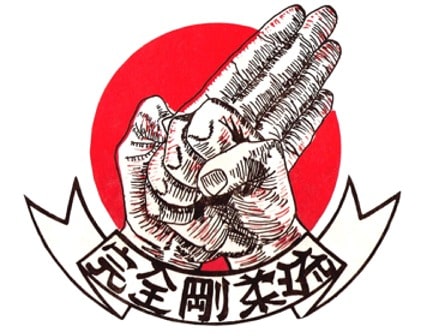Evolution

The origin of Goju Ryu Karate can be traced back to Kanryo Higaonna (Higashionna). Master Higaonna began his training in Okinawa under the tutelage of Arakaki (Araghi) Seisho who taught a martial art called “To-de”. Later he traveled to Fuzhou China where he trained under famous gongfu masters Xie Zhongxiang and Wai Xinxian. Many publications name Ryuru ko as Kanryo’s instructor in China, but many historians state that Xie Zhongxiang was in fact Ryuru ko.
Ryuru ko (Ryu Ryu Ko) studied White Crane gongfu and combined this with his own concepts to develop a hybrid art called Whooping Crane. Whooping Crane advocates leg maneuvers and body movements to avoid direct attacks.
When Kanryo Higaonna returned from China he began teaching his art. According to most sources he called his style Shorei Ryu (Enlightened Spirit Style); however it became commonly known as Naha-te (after the city Naha), to distinguish it from karate taught at Tomari and Suri cities.
One of Kanryo Higaonna’s most notable students was Chojun Miyagi. He became a student of Kanryo Higaonna at the age of fourteen and studied Naha-te for thirteen years. In 1915 Chojun Miyagi and a friend Gokenki who taught a form of White Crane boxing traveled to Fuzhou China to further their studies. Chojun Miyagi made several trips and spent one, possibly two years visiting and training with several Chinese masters.
Shortly after Chojun Miyagi’s return from Fuzhou, Kanryo Higaonna died and Sensei Miyagi, having a teaching certificate in Naha-te, began to take on students. Sensei Miyagi’s teachings were based not only on Naha-te but also the various other styles he was introduced to in China. His classes were also influenced greatly by his friend Gokenki’s teachings of White Crane boxing. When asked the name of his style he responded Goju Ryu.
Upon Master Chojun Miyagi’s death in 1953 several of his senior students branched out and started their own Goju Ryu organizations. The most famous in Japan was Gogen Yamaguchi. Gogen Yamaguchi was introduced to Chojun Miyagi in 1931(some historians suggest that this meeting occurred as late as 1935) by Jitsuei Yogi, a student of Chojun Miyagi. Chojun Miyagi occasionally visited and taught in Japan, in particular Ritsumeikan University where Gogen Yamaguchi had a Goju Ryu club. Chojun Miyagi gave Gogen Yamaguchi verbal approval to begin spreading Goju Ryu in mainland Japan.
In March 1978, Gogen Yamaguchi, together with his sons Gosei and Goshi, visited Okinawa and the dojo of Meitoku Yagi Sensei (Meibukan Goju Ryu), a senior student of Chojun Miyagi, for instruction in Goju Ryu kata. When Meitoku Yagi visited Japan he would go to Gogen Yamaguchi’s dojo and teach Okinawan Goju Ryu to to his son and daughter. Master Yagi had stated in an interview given when he was seventy eight years old that if you were to study at Gogen Yamaguchi’s dojo you can have the confidence that you are learning the advanced methods of Goju Ryu.
In the 1950s, Sensei Yamaguchi taught Peter Urban who being in the United States Navy, was stationed in Japan. While in Japan Sensei Urban had three instructors, Richard Kim, Masutatsu (Mas) Oyama and Gogen Yamaguchi. After spending nearly 7 years training in Japan he returned to the states as a 5th degree Black Belt representing Gogen Yamaguchi’s Goju Kai and began teaching.
I began my training in 1960 at Sensei Urban’s 17th street dojo in New York City. I trained with Sensei for eight years. During my time with Sensei I befriended another Brooklyn resident, Daniel Sullivan who began his training with Sensei in the mid 1960s. Our training also took place at the famous “Chinatown Dojo” on Canal Street.
I opened my first dojo on Coney Island Avenue in Brooklyn NY in 1966. Sullivan who lived not far from my dojo, would come and occasionally train with me. One of my first students was a seventeen year old named Joseph Mangravito. In 1968 I left Sensei Urban and at that time Daniel Sullivan joined my dojo full time. By 1969 I was teaching at my second location, Dick Andros Dance Studio on Flatbush Avenue in Brooklyn. At that time Michael DiRaimondo, a Purple Belt who was previously trained by my friend and dojo brother Frank Ruiz, joined my dojo.
In 1969 Frank Ruiz and I formed the Nisei Goju Ryu organization. There is where I met Thomas Graham and Frank Fair both Black Belts under Sensei Ruiz’s tutelage. When Ruiz was struck by a speeding car in 1970 and could not teach for over a year both Fair and Graham attended classes at my third dojo the “Brooklyn Dojo” on Flatbush Avenue. When Sensei Ruiz began teaching again, both Fair and Graham remained members of my dojo.
The main focus of the Nisei organization under Sensei Ruiz’s leadership was on kumite and tournament participation. I left Nisei in May of 1973 to concentrate more on traditional karate rather than the sport aspect. When I left Nisei, so did my most senior students which were comprised of Mangravito, Sullivan, DiRaimondo, Fair, and Graham.
On April 22, 1974, Kanzen Goju Ryu was formed with the aforementioned senior Black Belts as part of its Board of Directors. Since then, regretfully Daniel Sullivan and Frank Fair, who were so instrumental in Kanzen’s establishment, stopped training and retired from our organization. In May of 2004 Steven and Stuart Rosenstein were elected to Kanzen Goju Ryu’s Board of Directors. In 2012 Kanzen celebrated its 38th anniversary.
Harry Rosenstein

